Spring/Summer 2024


Spring/Summer 2024

The red-headed woodpecker, found in oak woodlands across Illinois, is one example of a species that is dependent on fire. The controlled application of fire—known as prescribed fire— helps clear dense brush from forest floors, ensuring that acorns get the sunlight they need to grow into oaks that attract the insects that woodpeckers eat. “Animals and plants have evolved with fire, and they depend on habitats that prescribed fire can help restore or support,” says The Nature Conservancy’s (TNC’s) Bill Kleiman, Illinois fire manager and project director at TNC’s Nachusa Grasslands Preserve.
This is why, for 60-plus years, TNC has embraced “good fire” as a key conservation strategy.
Without fire, Illinois prairies and woodlands quickly become overrun with invasive shrubs
and plants. Prescribed fire is healthy for the environment because it reduces these invaders, encouraging new growth of native plant species. In addition, across the United States, prescribed fire removes brush and small trees in native habitats, helping to prevent wildfires.
Prescribed fires on TNC preserves and partner lands are managed by our skilled fire teams, which have been trained to mitigate potential risks, says Kleiman. For example, the fire teams clear ground to create firebreaks, or strips of bare soil, which prevents flames from escaping the boundary of the area to be burned and helps keep burn crews safe. Considering wind direction and speed and other weather conditions also reduces smoke that may compromise air quality.
Fighting Western Wildfires 3 A Road Trip Around TNC Preserves
3 Test Your Native Plant Know-How
4 Technologies Aiding Conservation
5 Using e-DNA to Track Fish Species
5 From Coal Mine to Clean Energy Hub
6 Urban Nature Spotlights
7 Emiquon: Restoring the Jewel of the Illinois River
Board of Trustees
William M. Miller, PhD
Chair
Ann Suker Potter
Vice Chair
Rebecca Gerchenson
Treasurer
Yvonne Bruce
Luis Gutierrez
Kunal Kapoor
Lydia Link
Pin Ni
Yeming Rankin
Shari Rogge-Fidler
Mamadou-Abou Sarr
Alison Taylor
Matthew Walker
Karen Weigert
Donald J. Wuebbles, PhD
Trustees Emeriti
Philip D. Block IV
Lynne Dinzole
Lynn B. Donaldson
Peter H. Fenner
Christopher D. Gould
Ted Haffner
Ronald S. Levin
Ethan Meers
Richard E. Sparks, PhD
David L. Thomas, PhD
M. Jay Trees
Life Trustees
Harry W. Drucker
Constance T. Keller
Wendy J. Paulson
Brenda Shapiro
Nancy Hamill Winter
Executive State Director
Georgie Geraghty
International Headquarters
Arlington, Virginia
703-841-5300
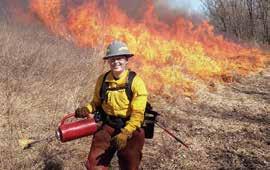
“There’s a quote that firefighters like to live by: ‘If you light ‘em, you better know how to fight ‘em.’”
TNC crews aid firefighting partners and gain vital skills.
Danielle Cafin helps light and manage prescribed fires to restore native landscapes as part of TNC’s fire and stewardship crew in Southern Illinois. Last summer, Cafin also helped suppress an out-of-control wildfire in British Columbia, which was sparked by downed power lines. “There’s a quote that firefighters like to live by: ‘If you light ‘em, you better know how to fight ‘em,’” says Cafin, senior burn crew member.
TNC burn staff, who are required to obtain the same strenuous training and certifications as federal wildland firefighters, have been helping partners put out wildfires for decades. After TNC fire crews register with an interagency dispatch center, they are deployed to fire locations across the United States and Canada. They pitch in with tasks like mapping hotspots with drones, managing water pumps and digging control lines (debris-free trenches) to prevent wildfires from threatening homes, livestock and wildlife habitats.
Besides helping to protect lands and lives, TNC has built partnerships with the government
agencies that oversee wildland firefighting to give TNC burn crews opportunities to practice skills that are also critical to managing prescribed fires. “It’s a huge hurdle to get enough people trained in prescribed fire, which is a critical tool to keeping our native habitats healthy,” says TNC’s Rob Littiken, project director at Kankakee Sands Preserve in Illinois.
Another way TNC is helping burn crews and managers gain needed skills and licenses is by offering a wildfire suppression training program in Belize, in partnership with TIDE Belize and Belize National Parks. About 20 people from TNC and other groups throughout the United States and Belize participate every year, getting hands-on experience putting out wildfires in the dry pine savannas and open grasslands of Belize’s national parks. “The Belize training has helped us train a lot more burn managers, which makes it possible for us to expand the use of prescribed fire to help restore prairies, woodlands and other natural areas,” Littiken says.

Scan the QR code or visit nature.org/ilfire to learn more.
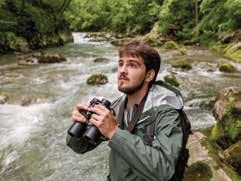
You don’t have to travel far to get away from it all. Across the Midwest, TNC preserves offer a nature respite—and opportunities for outdoor adventures. Plan your visit at nature.org/preserves
Pack your binoculars to catch a glimpse of waterfowl, warblers and other feathered
friends as they travel through the Great Lakes Basin, which offers important refueling spots for migrating birds. Check out: TNC’s Great Egret Marsh Preserve in Ohio along the Lake Erie coast.
TNC preserves across the region offer a range of trails and difficulty levels, from easy strolls to steep climbs. Check out: Central Indiana’s Green’s Bluff Nature Preserve, which features rocky bluffs and brand new hiking trails.
Embark on a treasure hunt by following online clues and coordinates to find hidden containers. Sign up at geocaching. com. Check out: TNC’s Mary Macdonald Preserve at Horseshoe Harbor in Michigan’s Upper Peninsula. On the drive there, listen
Would you like to attract more butterflies and other pollinators to your garden or window box—while reducing the need for watering and pesticides? Consider native plants. TNC’s Caleb Grantham, community engagement and conservation specialist, started a native plant garden three years ago and is delighted by all the wildlife that now visits his home. He shares some plant suggestions in the form of a quiz below.
1. What cactus is native to Illinois?
2. What native shrub produces white, edible flowers in the spring and dark purple berries in the summer that can be used to sweeten cakes, drinks, syrups and more?
3. What are two native plants, whose common names start with the letter “f,” that grow in shady areas?
4. What native plant shares the name of our state bird and grows well in wet areas of gardens?
5. What native perennial can be grown in a pot (as well as in the ground)
and attracts hummingbirds with its trumpet-shaped red and yellow flowers?
6. Name a late-blooming native with daisy-like flowers that will keep your garden or window box going through autumn.
Learn more about planting natives at nature.org/midwestnativegardens You can also find lists of native plant nurseries and sales on the Illinois Native Plant Society’s website (illinoisplants.org).
to an online audio tour about the unique history that shaped this preserve.
Whether in a canoe, kayak or other nonmotorized boat, paddling offers stunning views of coastline habitat, as well as the opportunity to spot wildlife who hunt, swim and nest offshore. Check out: TNC’s Caroline Lake Preserve in Wisconsin at the headwaters of the Bad River. You can also cast a line in the lake’s clear waters.
Until recently, you had to travel to Wyoming or other western states to see wild bison roaming. Today, you can see these giant mammals—which weigh 1,000 to 2,000 pounds—in Illinois and Indiana. Check out: TNC’s Nachusa Grasslands in Illinois or Kankakee Sands Preserve in Indiana.
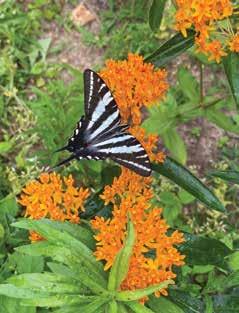
Across the Midwest, TNC and our partners are testing and adopting emerging technologies—from drones to artificial intelligence (AI)—to help us protect and restore lands and waters more e ciently and e ectively. “As a science-driven organization, TNC seeks to understand how innovative technologies can be applied successfully on our preserves and on our partners’ properties,” says Randy Smith, Illinois River project director.
Kayak
At TNC’s Emiquon Preserve, we are using drones equipped with video cameras to take high-quality aerial footage of hard-to-access areas. We plan to run the drone footage through AI-equipped software to identify where invasive plants are hiding. Drones can also be used to precisely spray invasive plants with herbicides, scatter native plant seeds and drop small fireballs to start prescribed fires.
Advances in animal and bird tracking are allowing scientists to learn more about the migratory behaviors of these creatures. The tower in the illustration, as well as the radio transmitters on the birds, represent the Motus Wildlife Tracking System (motus.org), a worldwide platform that is tracking hundreds of species of birds, bats and insects over vast distances.
Fish Ladder with AI
Emiquon sta have been working with partners to test a portable fish ladder designed to attract and sort fish along waterways. Equipped with a fish version of facial recognition software powered by AI, the ladder is designed to recognize and then capture invasive carp while allowing native fish to travel through the system.
Last fall, the U.S. Geological Survey (USGS) launched semi-autonomous kayaks onto Emiquon's waters. The kayaks are equipped with side-scanning sonar and steered by on-board GPS. The goals: identify where invasive carp hide and test the use of underwater sound to herd and capture the carp. Over the next two years, USGS will deploy the kayaks to collect carp data, which will be analyzed using AI. TNC hopes the information will guide a large-scale removal event where semi-truckloads of carp are flushed out and corralled.
Any viewer of crime shows knows the importance of DNA to catching criminals. Conservationists use a variation of this biological tool—called environmental DNA (e-DNA)—to detect wildlife species that have recently visited forest floors, river bends or other natural areas. Using molecular methods, scientists test soil or water samples for genetic material left behind by plants and animals.
TNC is using breakthrough e-DNA methods in conservation efforts across the globe. Here are two fish-related examples.
In 2009 and 2010, TNC’s Great Lakes team helped test and refine e-DNA methods as part of an effort to prevent invasive carp from entering the Great Lakes. Working with scientists from the University of Notre Dame, we collected and tested large numbers of samples, initially in Chicago canals and later across the Great Lakes, in an effort to detect the
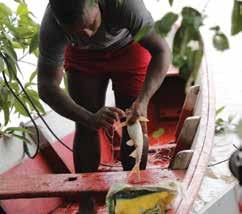
DNA and, hence, the likely presence of silver and bighead carp.
DNA evidence of invasive carp helped prompt federal and state agencies to refine barriers to prevent them from moving into Lake Michigan. “It has been exciting is to see the method continue to develop,” says TNC’s William Chadderton, program director, aquatic invasive species. “e-DNA is now used across the Great Lakes Basin—and globally—for both invasive species control and fisheries management.”
Dorado Catfish and the Amazon
More than 3,500 miles south of Lake Michigan, another e-DNA project aims to help ensure that dorado catfish can continue to make their annual migration along the Amazon River to spawn.
“These fish are hugely important to communities all along their migration,” says Paulo Petry, senior freshwater scientist for TNC’s Latin America region.
Petry worked with partners to use e-DNA to map the dorados’ journey down the Amazon. These catfish are known to migrate as far as 6,500 miles—the longest fish migration yet recorded. TNC and partners wanted to determine more details about their migration voyage, including which river corridors they visit.
Plans to add hydropower dams on the Amazon could disrupt the dorados’ migration. By having data on the dorados’ migration route, conservationists can advocate for shifting hydropower to areas that won’t harm the fish. Watch a video at nature.org/doradovideo
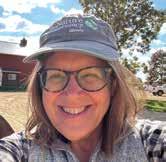
In April, Georgie Geraghty stepped into the position of Illinois executive director and Midwest partner of TNC, with a focus on propelling climate resiliency and nature-based solutions in the region. “We are all seeing and feeling the impacts of climate change and the loss of nature. But I am as hopeful as ever because local communities, decision-makers and influential businesses are pushing for much-needed change,” says Geraghty. “I’m excited to be a part of partnership-driven solutions with this remarkable TNC team.”
Born and raised in Bloomington, Ill., Geraghty has a proven record of connecting TNC insights and innovations locally, touching down in freshwater, renewable energy and climate, including championing the release of the Illinois Climate Assessment, the first-of-its-kind publication.
Geraghty began working with TNC in 1998, serving as TNC’s director of community-based conservation in Colorado. She has been with TNC in Illinois since 2016 and spent most of that time as deputy director. She brings more than 25 years of experience bridging conservation, law and fiscal expertise. “Georgie Geraghty demonstrates both visionary leadership and deep experience, which is what we need in this critical moment,” says Michael Reuter, TNC Midwest director. “We are working against the clock to cut global emissions and protect critical ecosystems around the world for people and nature.” Visit nature.org/ILDirector to learn more.



Located at Chicago’s southeast tip, Powderhorn Lake encompasses a 50-acre lake and the Powderhorn Marsh and Prairie Nature Preserve.
Home to about 200 bird and 250 plant species, Powderhorn is the only statededicated nature preserve within Chicago city limits. Unfortunately, invasive plants have been slowly degrading the habitat. To address this problem, the Forest Preserves of Cook County (FPCC) turned to TNC for help. Since 2017, a stewardship crew from TNC’s Indian Boundary Prairies preserve (IBP) has been working to control and reduce invasive species, such as reed canary grass and purple loosestrife. The recent installation of a water control structure by our partner Audubon Great Lakes allows FPCC to reduce or increase water levels in the preserve, which makes it possible for TNC to work in deep, highly degraded wetland areas. “Our work at Powderhorn is on track toward a full-site transformation with a healthy hydrology and community of plants and animals,” says Shane Tripp, IBP stewardship lead.
Envision Unlimited provides day programs and other supports to people with disabilities and other special needs in Chicago and central Illinois. Recently, the nonprofit began working with TNC and the Chicago Park District (CPD) to help get their members out in nature. TNC helps CPD manage the park’s Community Stewardship Program, which recruits volunteers to restore and maintain the park’s 100-plus natural areas, which include dunes, wetlands and prairies. In 2023, CPD and TNC held 10 stewardship events for Envision. “The Envision workdays were a great success,” says Edward Warden, TNC’s community stewardship program manager. Envision members learned how to collect seeds from native plants, remove invasive species and perform other restoration tasks. “Some Envision participants came to multiple events because they absolutely loved being outside and helping to care for the natural areas,” says Warden. Looking ahead, TNC, CPD and Envision are exploring how to empower Envision members to take a lead in stewardship activities on a regular basis.
At 6537 S. Wood St. in Chicago, you’ll find a vibrant community garden run by All Things Through Christ Outreach Ministries (ATTCOM). The garden, along with a youth program and food pantry, helps ATTCOM fight food insecurity and advocate for equity in Chicago’s West Englewood neighborhood. TNC’s Volunteer Stewardship Network—which provides financial and educational assistance to small volunteer groups that tend natural areas and community gardens—helped ATTCOM connect with other urban garden organizations. The ability to network with like-minded peers helped ATTCOM address a major gardening challenge: the lack of an easily accessible water source. Leaders from other community gardens connected ATTCOM with Chicago’s City Planning Department to get a permit to use a nearby fire hydrant. More recently, they helped ATTCOM add an irrigation system to keep plants hydrated. “TNC has always been about more than just the growing piece; they’re about linking communities,” says Reverend Gwen Sampson, ATTCOM vice president and COO.

Ask birdwatchers if they’ve heard of Emiquon and watch them light up.
During spring and fall migrations, the air here is filled with bird calls and the flurry of beating wings. Flocks of snow geese a million strong use TNC’s Emiquon Preserve, next to the Illinois River, as a critical stopover. The natural area supports many other birds, including bald eagles, white pelicans and sandhill cranes.
But Emiquon isn’t just a magnet for birds. Tens of thousands of human visitors come each year to view the spectacle. So when TNC decided to restore nearly 7,000 acres, people were a key part of the equation.
“As we started planning for the restoration and management of Emiquon Preserve, we invited a diversity of people from the community to participate,” says Doug Blodgett, senior advisor for TNC in Illinois. “We wanted to determine how to make the preserve something that would provide the people who live here with opportunities for recreation, education and economic development.”
“We want people to come out and see and support the amazing diversity here.”
In the 1920s, the wetlands that are now Emiquon Preserve were drained to provide land for farming. In addition, a levee (or long earthen hill) was built, isolating Emiquon from the Illinois River. The intention was to prevent the river from flooding farmlands after heavy rains.
TNC has successfully restored the former farmland back into a large floodplain wetland. Sometimes called the “kidneys” of rivers, floodplains are critical, low-lying areas that absorb and filter water while also supporting a diversity of wildlife.
A key step in the restoration was installing a water control structure in the levee, consisting of two gated, concrete pathways. This reconnected Emiquon to the Illinois River for the first time in nearly a century. Preserve managers can open or close the structure, allowing water to pass between
Emiquon and the river. The goal is to imitate the seasonal variations in flows that nature typically provides to help keep floodplains and the river healthy.
The restoration was guided by recommendations from the Emiquon Science Advisory Council, a group of 40 scientists and managers, and was based on computer models that evaluated different management scenarios.
Today, scientists from across the country come to Emiquon to conduct studies. Lessons learned at Emiquon are helping to guide large floodplain river restoration and management worldwide.
TNC kept visitors in mind throughout the restoration, adding spotting scopes, a boardwalk and a boat launch to the preserve. “We want to get people onto the landscape at Emiquon,” Blodgett says. “We want people to come out and see and support the amazing diversity here.”
Plan your visit at nature.org/emiquon
The Nature Conservancy in Illinois
400 N. Michigan Avenue, Suite 1100
Chicago, IL 60611-4163
nature.org/illinois
Spring/Summer 2024
facebook/TheNatureConservancyIllinois linkedin/TheNatureConservancyIllinois instagram/Nature_Illinois
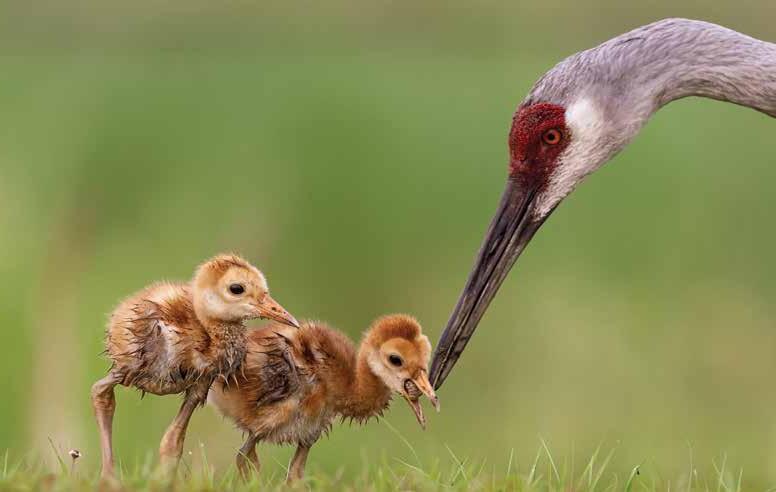
Every acre TNC protects, every mile restored, every species brought back from the brink, begins with you. A long-term gift to TNC’s Legacy Club would be invaluable to nature and people. For information, please contact Alex Burden at 312-580-2362. You can also give a one-time donation at nature.org/donateil
Sandhill Crane mama feeding colts © Mario Labado/TNC Photo Contest 2023